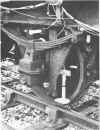
Author's Collection

Author's Collection

Author's Collection
Derailment Detection Device
|
At the end of 1974 the line was used to demonstrate a 'derailment detection device'. This was thought necessary since a large number of 4-wheeled vacuum braked wagons were still in use on BR and derailments were not uncommon. If after derailment the brake pipe remained complete, the derailed wagons could run for miles damaging the track and often the loco crew didn't even know they had a derailed wagon, the power of the modern diesels was unaffected by the extra drag. The device was connected to the braking system and consisted of one ceramic pipe above the vehicle's leaf springs and one attached to the axlebox. When the vehicle de-railed the gap above the spring was closed thereby breaking the element and venting the brake pipe, alternatively the one on the axlebox would come into contact with the rail head. Although successfully tested by deliberately de-railing a van the system was not really a practical proposition and was never developed any further. |